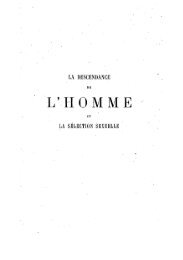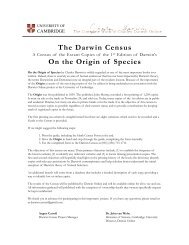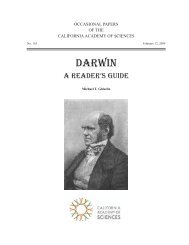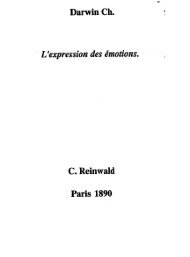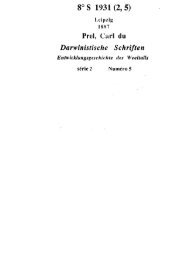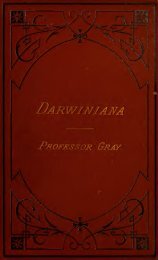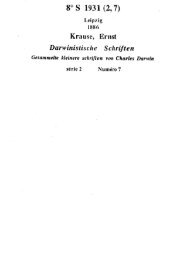Charles Darwin's Cambridge Life 1828-1831 - The Complete Work ...
Charles Darwin's Cambridge Life 1828-1831 - The Complete Work ...
Charles Darwin's Cambridge Life 1828-1831 - The Complete Work ...
Create successful ePaper yourself
Turn your PDF publications into a flip-book with our unique Google optimized e-Paper software.
Journal of <strong>Cambridge</strong> Studies<br />
2<br />
<strong>Charles</strong> Darwin’s <strong>Cambridge</strong> <strong>Life</strong> <strong>1828</strong>-<strong>1831</strong> 1<br />
John van WYHE ∗<br />
National University of Singapore<br />
Abstract: Darwin’s years in <strong>Cambridge</strong> were some of the most important and<br />
formative of his early life. For the rest of his life he felt a particular affection for<br />
<strong>Cambridge</strong>. For a time he even considered a <strong>Cambridge</strong> professorship as a career and<br />
he sent three of his sons there to be educated. Unfortunately the remaining traces of<br />
what Darwin actually did and experienced in <strong>Cambridge</strong> are very rare. Consequently<br />
his day-to-day life at Christ’s College has remained almost totally unknown. This<br />
article is based on new research, including newly discovered Christ’s College<br />
manuscripts and Darwin publications, and gathers together recollections of many of<br />
those who knew him as a student.<br />
Key Words: <strong>Charles</strong> Darwin, <strong>Cambridge</strong> University, Christ's College.<br />
In 1827 Darwin’s father proposed that his son become a clergyman. This was a respectable<br />
profession for a young man of his social background. Pre-requisite to becoming a clergyman in the<br />
Church of England was the acquisition of a B.A. degree from an English university.<br />
It has long been debated why Darwin came to Christ’s College, <strong>Cambridge</strong>. His grandfather, the<br />
poet Erasmus Darwin, went to St. John’s College. <strong>Darwin's</strong> school, Shrewsbury School, had<br />
connections to St. John’s. In 1821, Darwin’s cousin, Hensleigh Wedgwood (1803-1891), later a<br />
philologist and barrister, also went to St. John’s. At the time it had a reputation for strict discipline.<br />
Wedgwood migrated to Christ’s after only a single term. He took his B.A. in 1824 and was elected a<br />
Finch and Baines Fellow (one of the few Fellowships that did not require taking Holy Orders) of<br />
Christ’s in February 1829, a position he held until October 1830. Hence it is not surprising that his<br />
cousin, <strong>Darwin's</strong> brother Erasmus, joined Christ’s College on 9 February 1822. He received his M.B.<br />
in <strong>1828</strong>. Darwin’s second cousin, William Darwin Fox (1813-1881), later a clergyman naturalist,<br />
came up in 1824. It was therefore perfectly natural that Darwin would follow his cousins and brother<br />
to Christ’s. And equally that he join a college amenable to wealthy young men devoted to hunting<br />
and shooting.<br />
In Darwin’s day Christ’s was a quiet and relaxed institution, neither academically rigorous nor<br />
religiously strict. Darwin’s name was entered in the Admissions Books at Christ’s College on 15<br />
October 1827. It is often said that Darwin studied theology or divinity at <strong>Cambridge</strong>. This is not<br />
correct. Darwin was a candidate for an ordinary Bachelor of Arts degree, or B.A. After the B.A. he<br />
1<br />
I am grateful to Haiyan Yang for inviting me to contribute this article. It is based on my book Darwin in <strong>Cambridge</strong>. <strong>Cambridge</strong>:<br />
Christ’s College, 2009.<br />
∗ Senior Lecturer, Departments of Biology & History, National University of Singapore. E-mail: dbsjmvw@nus.edu.sg.
Vol 4. No.4 December 2009 Journal of <strong>Cambridge</strong> Studies<br />
3<br />
could have taken divinity training before taking Holy Orders. Darwin never undertook the divinity<br />
training. To earn a B.A. at <strong>Cambridge</strong> it was necessary to pass two university examinations, the<br />
‘Previous Examination’ in the second year, the B.A. Examination in January of the final year, and to<br />
reside ten terms in <strong>Cambridge</strong>.<br />
Darwin arrived in <strong>Cambridge</strong> on Saturday 26 January <strong>1828</strong>. He was eighteen years old. As the<br />
academic year began the previous October, all College rooms were already full. He therefore took<br />
lodgings above the premises of W. Bacon, tobacconist, in Sidney Street, less than a minute’s walk<br />
from the College Gate. Formal admission to the University followed Matriculation. <strong>The</strong> word<br />
derives from the requirement that undergraduates enter their names on the ‘matricula’ or role.<br />
Previous biographies have not included the correct date of Darwin’s matriculation. <strong>The</strong> first<br />
University matriculation ceremony after Darwin’s arrival in <strong>Cambridge</strong> was Ash Wednesday, 20<br />
February <strong>1828</strong>. On that day five men from Christ’s matriculated. Around one o’clock Freshman,<br />
grouped by college, gathered in the Senate House and signed their names in the Registrary’s book<br />
under the heading declaring they were bona fide members of the Church of England as by law<br />
established. Darwin signed as “<strong>Charles</strong> Robert Darwin”. <strong>The</strong>y took the Latin oaths of allegiance and<br />
supremacy before the Senior Proctor, that year Professor of geology Adam Sedgwick (1785-1873).<br />
Thus began Darwin’s lifelong association with the University of <strong>Cambridge</strong>.<br />
I. Darwin’s first year at Christ’s<br />
Settled in his lodgings overlooking the then narrow Sidney Street, Darwin began to make friends<br />
and renew old acquaintances. His brother Erasmus returned on 8 February. Perhaps lodging over the<br />
tobacconist’s shop led to some teasing. One friend, Albert Way (1805-1874) of Trinity College,<br />
drew a mock coat of arms for Darwin in April <strong>1828</strong>. This comic coat of arms depicts crossed<br />
tobacco pipes, meerschaum pipes, cigars, a wine barrel and beer tankards, evidently Darwin’s<br />
trademarks were meant to be drinking and smoking!<br />
Darwin also cultivated more sedate interests and opportunities available at <strong>Cambridge</strong>. Another<br />
friend, John Maurice Herbert (1808-1882), took Darwin to King’s College Chapel. Darwin recalled<br />
how a former Shrewsbury school friend, <strong>Charles</strong> Thomas Whitley (1808-1895), then at St John’s,<br />
“inoculated me with a taste for pictures and good engravings, of which I bought some. I frequently<br />
went to the Fitzwilliam Gallery [then in Free School Lane, now the Whipple Museum], and my<br />
taste must have been fairly good, for I certainly admired the best pictures, which I discussed with<br />
the old curator.” (Autobiography, p. 61) According to Herbert: “[Darwin] had a great liking for<br />
first-class line engravings — especially for those of Raphael Morghen & Müller; & he spent hours<br />
in the Fitzwilliam Museum in looking over the prints in that collection.” (Herbert 1882)<br />
Most of Darwin’s friends were from other colleges, as he recalled in later life “I do not think I<br />
knew even to bow to 15 men in college & was intimate with only 2 or 3 men.— Most of my friends<br />
belonged to Trinity & St. Johns & Emanuel [sic].” (Correspondence, vol. 7: 38) Perhaps Darwin’s<br />
closest friend at <strong>Cambridge</strong> was his second cousin, William Darwin Fox, who was also studying at<br />
Christ’s (admitted 26 January 1824) for an ordinary Arts degree with the aim of becoming a<br />
clergyman — like Darwin. Fox, again like Darwin, enjoyed riding, shooting and natural history. Fox<br />
was particularly fond of birds and insects. He kept a series of diaries which record in remarkable<br />
detail the life of a Christ’s undergraduate of the time. Darwin’s letters to Fox are now preserved in<br />
the College’s Old Library. <strong>The</strong>y provide a unique source for Darwin’s interests and activities as an<br />
undergraduate. After morning service in the College chapel Darwin often joined Fox for breakfast in<br />
his rooms just through the archway leading to Second Court in what is today E staircase. In after<br />
years Darwin fondly remembered “our antient snug breakfasts at <strong>Cambridge</strong>”. (Correspondence, vol.
Journal of <strong>Cambridge</strong> Studies<br />
4<br />
1: 223) “What pleasant hours, those were when I used to come & drink coffee with you daily!”<br />
(Correspondence, vol. 7: 196)<br />
It was apparently Fox who inspired Darwin to embrace the scientific hobby of collecting insects,<br />
especially beetles. Darwin was soon scouring the surrounding fields and fens for rare species. After<br />
fifty years Darwin’s <strong>Cambridge</strong> friend Frederick Watkins (1808-1888), at Emmanuel College, could<br />
still remember Darwin’s enthusiasm for Panagaeus cruxmajor, or the crucifix ground beetle, one of<br />
<strong>Darwin's</strong> favourites. It occurs in Wicken and other fens under sedge litter. Darwin later recalled in<br />
his Autobiography, p. 63, “I am surprised what an indelible impression many of the beetles which I<br />
caught at <strong>Cambridge</strong> have left on my mind. I can remember the exact appearance of certain posts,<br />
old trees and banks where I made a good capture. <strong>The</strong> pretty Panagaus crux-major was a treasure in<br />
those days”. Darwin’s notes in his copy of Stephens 1829, p. 13, record his capture of one: “Cam:<br />
Spring <strong>1828</strong>”. In June <strong>1828</strong> Darwin reported excitedly to Fox “I Have taken Clivina Collaris, fig 3<br />
Plate III of Stephens”. Herbert recounted how one of the beetles was examined: “One day in his<br />
rooms he doped a large Beetle with a penful of prussic acid. <strong>The</strong> creature almost instantaneously<br />
kicked & fell over on his back apparently dead — but after a few minutes exposure to the lense it<br />
rallied and wattled off as if nothing had happened to it, to our general amazement.” (Herbert 1882)<br />
[Figure 1]<br />
Figure 1<br />
Darwin returned home to Shrewsbury for the summer. He visited friends and relatives for shooting<br />
and beetling. On 1 July <strong>1828</strong> Darwin set out for Barmouth, Wales for what he called his “Entomo-<br />
Mathematical expedition” a study holiday with a few other <strong>Cambridge</strong> undergraduates and their<br />
private tutors. Darwin’s mathematical tutor was George Ash Butterton (1805-1891) of St. John’s.<br />
Darwin spent most of his time in Barmouth with two particular friends, Herbert and Thomas Butler<br />
(1806-1886), the son of the headmaster of Shrewsbury School. What the tutor did while Darwin<br />
scrambled over mountains and popped beetles into bottles is not recorded. Herbert later described<br />
Darwin’s activities.<br />
On 27 August Darwin left Barmouth early for the start of the shooting season on 1 September. He<br />
returned to <strong>Cambridge</strong> for the Michaelmas Term on 31 October <strong>1828</strong>. Finally, there was a free room<br />
in College and the Tutor assigned Darwin to a comfortable set on the south side of First Court. <strong>The</strong>re
Vol 4. No.4 December 2009 Journal of <strong>Cambridge</strong> Studies<br />
5<br />
is a tradition that these rooms were once occupied by the famous natural theologian William Paley<br />
(1743-1805). No evidence at Christ's College has been found to substantiate this story. However<br />
many such College traditions are surprisingly accurate. When writing to his son William in 1858,<br />
Darwin mentioned his College rooms: “You are over the rooms which my cousin W. D. Fox had &<br />
in which I have spent many a pleasant hour.— I was in old court, middle stair-case, on right-hand on<br />
going into court, up one flight, right-hand door & capital rooms they were.” William was at the time<br />
staying in E6, though he later lived in his father's old rooms. (F. Darwin 1914) Darwin gave this<br />
lengthy description of the location because the College staircases were not then named with letters<br />
as they are today. <strong>Darwin's</strong> rooms are now known as G4. <strong>The</strong> rent was normally £4 per quarter.<br />
Darwin’s rooms consisted of a panelled main sitting room (c. 8 x 8m) with an adjoining dressing<br />
room and bedchamber. His three windows on the north overlooked First Court, with the Chapel<br />
directly across from him. His postulated clerical future was never out of view. <strong>The</strong> Master’s Lodge<br />
was to its right and closer still the Hall. Darwin’s south facing windows overlooked what was<br />
formerly called Bath Court and is today the site of the new undergraduate library. [Figure 2]<br />
It was possible to buy the furniture left by the previous tenant from the College upholsterer. Darwin<br />
may have done so. It was common to buy crockery, tea sets, decanters and wine glasses from the<br />
bedmaker. A large bill of £40 5s 6d for a woollen draper in the Easter term may have been for a<br />
carpet ordered for his new rooms. In December Darwin wrote to his brother Erasmus “After you left<br />
<strong>Cambridge</strong> I got into very nice rooms in College, far more comfortable than lodgings, as you will<br />
find when you come next to <strong>Cambridge</strong>. I imbibed your tastes about prints, and put it into practice,<br />
and have bought some very good prints, which I long for you to see.” (Correspondence, vol. 1: 71)<br />
A college servant, known in <strong>Cambridge</strong> as a gyp, was assigned to each staircase. <strong>The</strong> word gyp is<br />
from the Greek for vulture, though by Darwin’s time the reason why gyps were thus named was lost<br />
in obscurity. Darwin’s gyp is recorded simply as ‘Impey’. Gyps delivered letters, brushed clothes,<br />
ran errands and made coffee. <strong>The</strong> College porters took letters to and from the post office. Another<br />
servant known as a shoeblack cleaned and polished shoes and boots. <strong>The</strong>se services were listed<br />
Figure 2
Journal of <strong>Cambridge</strong> Studies<br />
6<br />
separately in the College accounts for each student. For example, in the quarter ending Lady Day<br />
(25 March) 1830 Darwin was charged £4.12.6 for coal, 7 shillings for the shoeblack and £2 one<br />
shilling for the barber.<br />
A typical day at Christ’s College for Darwin probably began around 7am when he was awoken by<br />
Impey in time to dress for Chapel at 7.30. While attending Chapel the bedmaker would come in and<br />
make the bed. This too was charged on the account, in this case £1 one shilling for the same quarter.<br />
Darwin would return from Chapel and have breakfast in his room before a blazing coal fire with the<br />
kettle boiling on the grate. <strong>The</strong> table was laid by Impey and the College breakfast, according to the<br />
recollection of a near contemporary at Trinity, consisted of: “the fourth part of a half-quartern loaf,<br />
and twopenny-worth of butter”. ([Atkinson] 1825, p. 507) Tea and coffee and any other extras were<br />
provided or paid for by the student. After breakfast Impey cleared the breakfast things.<br />
Clearly a wide variety of activities took place in Darwin’s rooms. He read for his College curriculum,<br />
wrote letters, compared his captured beetles with published descriptions in his copy of Stephens<br />
Systematic catalogue of British insects and carefully pinned the beetles to cork boards. He had<br />
friends to coffee, and in the evenings they sometimes dined there and would then drink wine and<br />
play cards. Darwin recalled in his Autobiography, p. 61: “I used generally to go by myself to King’s<br />
College, and I sometimes hired the chorister boys to sing in my rooms.” Herbert remembered<br />
accompanying Darwin to the afternoon service at Trinity “when we heard a very beautiful anthem<br />
— At the end of one of the parts, which was exceedingly impressive, he turned round to me & said<br />
with a deep sigh “How’s your backbone?” (Herbert 1882)<br />
Even before coming up to <strong>Cambridge</strong> Darwin was a passionate sportsman. In October <strong>1828</strong><br />
Darwin’s father and sisters contributed £20 towards the purchase of a new double barrelled shotgun.<br />
With it Darwin often went shooting in the surrounding fens. He also acquired a dog named Dash.<br />
About this time, Herbert recalled that he and Darwin had an “earnest conversation about going into<br />
Holy Orders; & I remember his asking me with reference to the question put by the Bishop in the<br />
Aduration service: “Do you trust that you are inwardly moved by the Holy Spirit &c” whether I<br />
could answer in the affirmative—: & on my saying “I could not,” he said “neither can I, &<br />
therefore…I can not take orders.” (Herbert 1882) However in a letter from May 1830 Darwin wrote<br />
to Fox “I have some thoughts of reading divinity with [Henslow] the summer after next.”<br />
(Correspondence, vol. 1: 104)<br />
Chapel<br />
Members of the College were called to Chapel by the bell, which rang for five minutes as the start<br />
of services approached at 7.30am. Students were probably required to attend Chapel eight times per<br />
week, at least one service per day and twice on Sunday. Undergraduates probably rotated through<br />
Chapel readings. It is interesting to note, and it seems no biography has ever done so, that <strong>Charles</strong><br />
Darwin may well have stood at the lectern in Christ’s College Chapel and read from the Bible.<br />
Far from being an establishment-defending and entrenched Anglican stronghold Christ’s had a large<br />
percentage of reform-minded Fellows. “In 1837 a draft of a new body of statutes was made, and on<br />
24 February 1838 an order was signed by the Master and ten Fellows (including Shaw, Baines, and J.<br />
Cartmell, the future Master) that a petition for the substitution of [the Elizabethan] Statutes should<br />
be presented to the Queen. … [the draft statutes] seem to have permitted the marriage of Fellows,<br />
and some participation in College emoluments by persons not members of the Church of<br />
England. …Divine service should be held on Sundays only in the College chapel…” (Peile 1900, p.<br />
279) and so forth. However, the draft was unsuccessful. Darwin’s tutors, Shaw and Graham, are<br />
buried in the ante-chapel. <strong>The</strong>ir Latin-inscribed tombestones in the floor can still be read today.
Vol 4. No.4 December 2009 Journal of <strong>Cambridge</strong> Studies<br />
7<br />
College Lectures<br />
After breakfast in their rooms students were expected to attend the two College lectures in the<br />
lecture room, probably from 9-11am. In his Autobiography, p. 58, Darwin recalled “With respect to<br />
Classics I did nothing except attend a few compulsory college lectures, and the attendance was<br />
almost nominal.”<br />
After College lectures students might have tea or coffee in their rooms and were free to visit friends<br />
or go for walks. Around 1.00 it was customary to visit private tutors. Dinner was then at 4.00 in Hall.<br />
For Pensioners like Darwin the meal or commons provided consisted only of joints of meat and beer.<br />
However extras could be purchased such as vegetables, pies and cheese. In fact the College record<br />
book T.11.25 had a separate column for vegetables next to the record for commons. In <strong>1828</strong><br />
vegetables were charged at “5 ½ p/day”. In the first quarter of Darwin’s residence in <strong>Cambridge</strong> his<br />
vegetable bill came to £1 2s 5½d. (T.11.25)<br />
<strong>The</strong> Hall<br />
<strong>The</strong> Hall was the largest building in Christ’s College, and the place where members of the College<br />
gathered for dinner. <strong>The</strong> Hall today is quite different from its appearance in Darwin’s day. “In 1723<br />
money was given to “beautify” it: which was done by putting deal wainscot over the oak panelling,<br />
by covering up the old fireplace, and by hiding the roof with a cylindrical plaster ceiling.” It<br />
remained thus until 1875 when “the old roof was removed, reconstructed, and replaced; the walls<br />
were rebuilt and raised about 6 feet…and new oak panelling was put up, some of the original work<br />
being sufficiently sound to remain at the south end.” <strong>The</strong> panelling at the north end was added in<br />
1900. (Peile 1900, p. 31) In 1882 and in following years stained glass portraits were added to the<br />
Hall’s west oriel. Darwin is represented in the top right and final panel in his scarlet honorary LL.D.<br />
gown. <strong>The</strong> work was done by Messers. Burlison and Grylls. (Peile 1900 p. 16)<br />
Before the meal a Latin grace was read. <strong>The</strong> Fellows and Fellow Commoners ate a three course meal<br />
with port or sherry at their own table on a raised dais at the north end of the Hall. <strong>The</strong> Pensioners sat<br />
together at long tables at the south end of the Hall. <strong>The</strong> Sizars acted as waiters. After dinner the<br />
Fellows and Fellow Commoners would retire to the Combination Room located upstairs behind the<br />
gallery at the south end of the Hall. Here they would drink wine or port and converse until evening<br />
Chapel at 6pm.<br />
On 20 December <strong>1828</strong> Darwin arrived back in Shrewsbury with his new dog Dash. He visited<br />
friends and relatives in Shropshire and Staffordshire for shooting and visits. In a January 1829 letter<br />
to Fox Darwin made a rare reference to his College studies: “my Studies consist of Adam Smith &<br />
Locke, in the latter of which I suppose you are an adept, & I hope you properly admire it— About<br />
the little Go I am in doubt & tribulation. I have had very little shooting.” (Correspondence, vol. 1:<br />
74) <strong>The</strong> “little Go” was the nickname for the University’s Previous Examination, which<br />
undergraduates took in their second year. According to the <strong>Cambridge</strong> University Calendar, 1829, p.<br />
169, “<strong>The</strong> subjects of examination are one of the four Gospels or the Acts of the Apostles in the<br />
original Greek, Paley's Evidences of Christianity, one of the Greek and one of the Latin Classics”.<br />
Locke’s An essay concerning human understanding appeared in the B.A. examination for those who<br />
were not candidates for honours. <strong>The</strong> work by Adam Smith, probably his <strong>The</strong>ory of Moral<br />
Sentiments, did not appear in the Previous or B.A. Examinations. It may have been a reading<br />
assigned by his College Tutor or Lecturer. Before returning to <strong>Cambridge</strong> for Lent Term Darwin<br />
stayed with his brother in London.
Journal of <strong>Cambridge</strong> Studies<br />
8<br />
II.Darwin’s Second Year at Christ’s<br />
Darwin returned to Christ’s on 24 February 1829. Fox was gone; he had taken his B.A. degree on 23<br />
January, ranking 88 th out of 160 students. Earlier in the month, Darwin’s cousin Hensleigh<br />
Wedgwood was elected a Finch and Baines Fellow, but he would hold this only until October 1830<br />
(he resigned because of his religious doubts). Two days after returning to his comfortable rooms<br />
Darwin wrote Fox to report on his stay in London where he had visited entomologists F. W. Hope<br />
and J. F. Stephens. <strong>The</strong> former had generously given Darwin specimens of 160 beetle species for his<br />
collection. Darwin ordered a beetle cabinet for £15 to help house his growing collection. This<br />
cabinet must have been rather large. Darwin also reported that “By Grahams decided advice, I do<br />
not go in for my little Go.” John Graham (1794-1865) replaced Shaw as Tutor in 1829. Shipley<br />
described Graham as “one of the most brilliant of the alumni of the College (fourth Wrangler and<br />
Chancellor’s Classical Medallist in 1816), who was elected Master of the College in 1830, and was<br />
appointed to the Bishopric of Chester in 1848. Graham was one of the small group of <strong>Cambridge</strong><br />
Liberals in the days of the first Reform Bill, and a strong supporter of the abolition of University<br />
tests. As a disciplinarian in College he is said to have been somewhat too easy-going”. (Shipley<br />
1924, p. 127)<br />
On 15 March Darwin wrote to Fox of the routine in his College rooms: “I am leading a quiet everyday<br />
sort of a life; a little of Gibbons history in the morning & a good deal of Van. John [Blackjack],<br />
in the evening this with an occasional ride with Simcox & constitutional with Whitley, makes up the<br />
regular routine of my days.”<br />
At the beginning of June Darwin may have received the latest number of Stephens’ Illustrations of<br />
British entomology, Haustellata vol. 2 (appendix) dated 1 June 1829. On page 200 appeared the<br />
record of Darwin’s capture of a Graphiphora plecta (a moth) and the first word Darwin ever<br />
published: “<strong>Cambridge</strong>”, the location provided by Darwin as the site of capture. On the 15 th another<br />
number of Stephens appeared, this time with thirteen species of beetle collected by Darwin. He later<br />
described the feeling of seeing his captures in print: “No poet ever felt more delight at seeing his<br />
first poem published”. (Autobiography p. 63) [Figure 3]<br />
Figure 3<br />
For a time between <strong>1828</strong> and the summer of 1829 Darwin kept a list of beetle species in an old<br />
Edinburgh notebook (DAR 118). He also wrote annotations next to the descriptions of 281 species<br />
in Stephens 1829 — sometimes recording where he collected a species with the date or the person<br />
who gave him a specimen. Darwin’s copy is in the <strong>Cambridge</strong> University Library. He obviously<br />
became more proficient in capturing and identifying beetles over the years.<br />
He returned to Shrewsbury and continued his usual lifestyle of shooting and beetling in Shropshire<br />
and Staffordshire. In mid-June he went on an entomological tour in North Wales with F. W. Hope.<br />
In July Darwin wrote to Fox that, although he planned to entomologize and shoot throughout the<br />
summer, he also needed to prepare for the Previous Examination. “I must read for my little Go.<br />
Graham smiled & bowed so very civilly, when he told me that he was one of the six appointed to<br />
make the examination stricter, & that they were determined they would make it a very different<br />
thing from any previous examination that from all this, I am sure, it will be the very devil to pay<br />
amongst all idle men & Entomologists.” (Correspondence, vol. 1: 89)
Vol 4. No.4 December 2009 Journal of <strong>Cambridge</strong> Studies<br />
9<br />
In early October Darwin attended a music meeting in Birmingham with his Wedgwood relations. He<br />
returned to Christ's on 12 October 1829. (T.11.25) He entomologized with Leonard Jenyns (later<br />
named Blomefield) (1800-1893), vicar of nearby Swaffham Bulbeck. Darwin became a fixture at the<br />
Friday evening soirées at the home of the Professor of Botany, John Stevens Henslow (1796-1861),<br />
where the scientifically-minded of the University, young and old, were welcomed.<br />
Darwin also enrolled in Henslow’s university botany lectures three times between 1829-<strong>1831</strong>.<br />
Darwin recalled that he “liked them much for their extreme clearness, and the admirable illustrations;<br />
but I did not study botany. Henslow used to take his pupils, including several of the older members<br />
of the University, field excursions, on foot, or in coaches to distant places, or in a barge down the<br />
river, and lectured on the rarer plants or animals which were observed. <strong>The</strong>se excursions were<br />
delightful.” (Autobiography, p. 60) Many years later Darwin referred to his friendship with Henslow<br />
as the most important influence during his time at <strong>Cambridge</strong>.<br />
In early November Erasmus stayed with Darwin for a few days. <strong>The</strong> brothers spent long hours at the<br />
gallery of the Fitzwilliam Museum. Thus ended Darwin’s second year at Christ’s College. He had<br />
settled into a congenial world of genteel pleasures and pastimes. As Janet Browne noted “[Darwin’s]<br />
<strong>Cambridge</strong> was an easy-going affair, for the most part happily engaged with the internal world of his<br />
college in preference to any of the wider issues that might rampage outside.” (Browne 1995, p. 93)<br />
III.Darwin’s Third Year at Christ’s<br />
After the Christmas break Darwin returned from London to Christ's on New Year's Day 1830. About<br />
this time Darwin and seven friends formed a weekly dining club called the “Gourmet Club” or<br />
“Glutton Club”. <strong>The</strong> club consisted of Darwin, Herbert, Whitley, Watkins, Cameron, James<br />
Heaviside of Sidney Sussex College, Robert Blane of Trinity College and Henry Lowe of Trinity<br />
Hall. <strong>The</strong>y dined in each other’s rooms in rotation.<br />
<strong>Cambridge</strong> did not consist exclusively of dining, shooting and beetling for Darwin. In addition to his<br />
College lectures and readings he had to pass the two set University examinations. On Wednesday 24<br />
March 1830, after weeks of fervent cramming, Darwin nervously entered the Senate House to take<br />
the Previous Examination or “Little Go”. Candidates were examined orally, in turn. Three hours in<br />
the morning were spent on the classics and three hours in the afternoon on the New Testament and<br />
Paley. Darwin passed the examination.<br />
In March Darwin wrote Fox “My new [beetle] cabinet is come down & a gay little affair it is.” In a<br />
later letter written from Shrewsbury Darwin described the cabinet from memory: “<strong>The</strong> man who<br />
made my cabinet is W. Edwards 29 Wilton St. Westminster. I advise to get one bigger than mine.—<br />
Mine cost £5.10. & contained 6 drawers, depth, 1 f,, 3. breadth 1 f,, 7.—& whole cabinet stood in height<br />
1”4.—” (Correspondence, vol. 1:127) I found a cabinet in the possession of Dr Milo Keynes, a<br />
great-grandson of Darwin, which Keynes used as his television stand. He believed his collecting<br />
cabinet came from Down House and belonged to Darwin. Dr Keynes recalled that the cabinet<br />
contained shells when he inherited it from his mother. <strong>The</strong> cabinet somewhat resembles the one<br />
described by Darwin. <strong>The</strong> firm of Cheffins Antiques in <strong>Cambridge</strong> estimated the cabinet dates from<br />
the early nineteenth century. It is made of mahogany, contains six shallow drawers which have corklined<br />
bases. Some have a camphor compartment at the front. At some later point the drawers were<br />
lined with paper. In some places the paper has been torn away revealing the cork. In one of these<br />
exposed areas two very fine insect pins are stuck in the cork, and bent over. Inside one of the<br />
camphor compartments was a minute printed label: “LIGUSTRI Privet.”, (a type of moth). This label<br />
is almost certainly remains of use of the cabinet after Darwin’s time.
Journal of <strong>Cambridge</strong> Studies<br />
10<br />
In April Darwin wrote to Fox “I find I get on very slowly with my cabinet, & shall be very glad of<br />
your assistance. I have only yet got to the Amarœ.—… I have been seeing a good deal lately of Prof:<br />
Henslow; I took a long walk with him the other day: I like him most exceedingly, he is so very<br />
goodnatured & agreeable”.<br />
On 3 June 1830 Darwin was recorded as leaving Christ’s at the end of Easter Term. He spent a few<br />
days in London before heading north to Shrewsbury. In August he returned to North Wales for<br />
collecting beetles and fishing followed by the usual rounds of shooting in Shropshire and<br />
Staffordshire. In September he wrote to Fox about his new horse which he hoped would make a very<br />
good hunter. Darwin took the horse with him to <strong>Cambridge</strong> when he returned to Christ’s on 7<br />
October 1830, for the start of the Michaelmas Term. He wrote to Fox “I arrived here in my most<br />
snug & comfortable rooms yesterday evening”. In November Darwin wrote to Fox that because of<br />
all the reading involved in “getting up all my subjects” he was left no time to catch or send insects.<br />
Darwin paid Henslow to act as his private tutor in mathematics. Darwin wrote to Fox that “the hour<br />
with him is the pleasantest in the whole day”. At Henslow’s botany lectures Darwin helped to<br />
arrange the specimens and materials before the lectures, and was generally considered to be<br />
Henslow’s favourite. William Allport Leighton, an old Shrewsbury school friend, recalled: “I<br />
remember that the Professor in the concluding remarks at the close of his course of lectures said he<br />
hoped his teaching had influenced many to perseverance — certainly he knew it had influenced one<br />
— no doubt he meant Darwin.” (Leighton 1886)<br />
Darwin spent the Christmas vacation of 1830 in <strong>Cambridge</strong> preparing for his final examination.<br />
Only after the voyage of the Beagle would Darwin reject Paley’s argument of design, already quite<br />
outdated by the 1830s. (Hanging in the College Old Library is the last College Paley examination<br />
paper from 1920.)<br />
IV.Darwin’s Last Terms at Christ’s<br />
Darwin’s final examination for the B.A. degree, which consisted of three days of written papers,<br />
occurred between 14-20 January <strong>1831</strong>. Darwin was a poll candidate. <strong>The</strong> poll (an abbreviation of the<br />
Greek ‘Hoi Polloi’ for the crowd) consisted of those students who took an ordinary pass degree<br />
rather than an honours degree. <strong>The</strong> examination consisted of six parts: Homer, Virgil, Euclid,<br />
arithmetic and algebra, Paley’s Evidences of Christianity and Principles of moral and political<br />
philosophy, and Locke’s An essay concerning human understanding.<br />
<strong>The</strong> papers were marked by Friday 21 January. On Saturday the 22 nd a second edition of the<br />
<strong>Cambridge</strong> Chronicle appeared which showed Darwin placed 10 out of 178 in the polls. <strong>The</strong>re were<br />
only 86 honours candidates that year. As Darwin recalled in his Autobiography, p. 59, “By<br />
answering well the examination questions in Paley, by doing Euclid well, and by not failing<br />
miserably in Classics, I gained a good place among the δτ πολλοι, or crowd of men who do not go in<br />
for honours”. However, Darwin had not resided the requisite number of terms so he could not yet be<br />
awarded his degree. His final two terms at Christ’s, without the pressure of preparing for<br />
examinations, were some of the most important he spent in <strong>Cambridge</strong>.<br />
In February he read J. F. W. Herschel’s Preliminary discourse (<strong>1831</strong>), an authoritative and thoughtprovoking<br />
model on correct methods of scientific investigation. It was essentially a survey of the<br />
science of the day, as well as an account of the progress of scientific knowledge. Herschel’s law of<br />
continuity meant that all parts of nature and science would be interconsistent. Given the collection of<br />
enough facts, powerful general laws could be deduced. Darwin also read Alexander von Humboldt’s<br />
Personal narrative of his expedition to northern South America.
Vol 4. No.4 December 2009 Journal of <strong>Cambridge</strong> Studies<br />
11<br />
Some years later Darwin described his time in <strong>Cambridge</strong> after his degree: “During these months<br />
lived much with Prof. Henslow, often dining with him, & walking with. became slightly acquainted<br />
with several of the learned men in <strong>Cambridge</strong>. which much quickened the little zeal, which dinner<br />
parties & hunting had not destroyed. In the Spring…talked over an excursion to Teneriffe.” (Journal)<br />
Darwin’s planned trip to Tenerife, in the footsteps of Humboldt, never materialized.<br />
At the end of April Darwin’s degree was conferred, along with one other student from Christ’s.<br />
Darwin signed the Subscriptions book “<strong>Charles</strong> Robert Darwin Christ. Coll: April 26. th <strong>1831</strong>” Two<br />
days later he wrote to his sister Caroline: “I took my Degree the other day: it cost me £15: there is<br />
waste of money.” (Correspondence, vol. 1: 122) Nevertheless Darwin’s degree is officially recorded<br />
in 1832. Francis Darwin explained: “he was unable to take his degree at the usual time,—the<br />
beginning of the Lent Term, <strong>1831</strong>. In such a case a man usually took his degree before Ash-<br />
Wednesday, when he was called “Baccalaureus ad Diem Cinerum,” and ranked with the B.A.’s of<br />
the year. My father’s name, however, occurs in the list of Bachelors “ad Baptistam,” or those<br />
admitted between Ash-Wednesday and St. John Baptist’s Day (June 24th); he therefore took rank<br />
among the Bachelors of 1832.” (F. Darwin 1887, vol. 1: 163)<br />
His father gave him £200 to settle his <strong>Cambridge</strong> debts before closing this part of his life. Darwin’s<br />
time at Christ’s College came to an end when he finally left after the Easter Term on 16 June <strong>1831</strong>.<br />
V.Voyage of the Beagle – and Return to <strong>Cambridge</strong><br />
In August <strong>1831</strong> Darwin took an important and instructive geological tour of Wales with Adam<br />
Sedgwick. Upon returning home, Darwin received a letter from Henslow which changed his life, and<br />
the world, forever. It was the offer to travel on board HMS Beagle as naturalist. After visiting<br />
Henslow in <strong>Cambridge</strong> and hurried preparations Darwin departed on the Beagle in December <strong>1831</strong>.<br />
<strong>The</strong> Beagle voyage is recounted in many works, foremost of which is Darwin’s own Journal of<br />
researches (1839). Throughout the voyage Darwin shipped home thousands of geological, botanical<br />
and zoological specimens to Henslow in <strong>Cambridge</strong>.<br />
<strong>The</strong> Beagle returned to England in October 1836, after circumnavigating the globe. After<br />
disembarking Darwin went directly to Shrewsbury to see his family, before moving back to<br />
<strong>Cambridge</strong> to arrange his veritable mountain of specimens in December 1836. At first he considered<br />
living in Christ’s College and inquired about rooms from the Tutor, Ash. But as Darwin felt he<br />
would probably need to move to London after a few months, the year-long College accommodation<br />
arrangement, as well as the need to furnish it and buy crockery etc., was inconvenient. Instead,<br />
Adam Sedgwick found lodgings for Darwin at 22 Fitzwilliam Street. <strong>The</strong> house is marked today<br />
with a stone plaque. Darwin arrived in <strong>Cambridge</strong> on 13 December and stayed with Henslow. On<br />
the afternoon of his arrival Joseph Romilly visited the Henslows, as he recorded in his diary: “Drank<br />
tea with M rs Henslow to meet Marchesa &c: here also I met M r Darwin (g[rand]. s[on]. of Bot c<br />
Garden) who is just returned from his travels round the world: he declares that in ‘terra del fuego’<br />
whenever a scarcity occurs (wch is every 5 or 6 years) they kill the old women as the most useless<br />
living creatures: in conseq. when a famine begins the old women run away into the woods & many<br />
of them perish miserably there...” (Bury 1967. p. 110.)<br />
Darwin wrote to Fox on 15 December “It appears to me, most strange to stand in the court of Christ,<br />
and not to know one undergraduate: It was however some kind of satisfaction to find all the old<br />
“gyps””. On 16 December Darwin moved into his lodgings in Fitzwilliam Street. He continued to<br />
dine at Christ’s. <strong>The</strong> College wine book demonstrates that he dined at Christ’s on 19 October during<br />
a short stay in <strong>Cambridge</strong> and was possibly listed as “MA” for 26 December. On the 29 th "Mr<br />
Darwin [fined for being] too late in hall.” He paid his fine with a half bottle of port on each of the
Journal of <strong>Cambridge</strong> Studies<br />
12<br />
two following evenings. On 23 February 1837 Darwin bet one of the Fellows, Edward Baines, that<br />
he could guess the height of the ceiling in the Combination Room (now the Old Combination Room)<br />
overlooked by a portrait of the Foundress of the College, Lady Margaret Beaufort, and a full length<br />
portrait of William Paley.<br />
23 Feb. 1837. Mr Darwin v. Mr Baines. That the Combination Room measures from the<br />
ceiling to the floor more than (x) feet.<br />
N.B. Mr Darwin may measure at any part of the room he pleases. (F. Darwin 1887, vol. 1:<br />
279)<br />
Darwin’s name is crossed through, which means he lost the bet. It was forbidden to bet for money,<br />
so bets were always for a bottle of port. Indeed if the person laying a bet forgot to say it was for a<br />
bottle, he could be fined a bottle! Interestingly, Baines bet on the height of the Combination Room<br />
ceiling several years before, so he probably knew he would beat the world traveller.<br />
Darwin recorded in his pocket diary or Journal “Jan [1837]: <strong>Cambridge</strong> — time spent in arranging<br />
general collection; examining minerals, reading, & writing little journal in the evenings Paid two<br />
short visits to London. — & read paper on elevation of coast of Chile.” On 27 February he presented<br />
a paper at a meeting of the <strong>Cambridge</strong> Philosophical Society. <strong>The</strong> minutes of the General Meeting<br />
record: “An account by Mr C. Darwin of fused sand tubes found near the Rio Plata, which were<br />
exhibited along with several other specimens of rocks.” Darwin wrote to his sister Caroline: “I have<br />
just been reading a short paper to the Philosoph. Soc y . of this place, and exhibiting some specimens<br />
& giving a verbal account of them. It went off very prosperously & we had a good discussion in<br />
which Whewell & Sedgwick took an active part. … On Friday morning I migrate [to London]. My<br />
<strong>Cambridge</strong> life is ending most pleasantly.” (Correspondence, vol. 2: 8-10) Apparently on 6 March<br />
1837 Darwin moved to London to be closer to the scientific colleagues and institutions who were<br />
discussing his Beagle collections. (Journal) Darwin wrote to Fox from London “<strong>The</strong> only evil I<br />
found in <strong>Cambridge</strong>, was its being too pleasant”. (Correspondence, vol. 2:11) Darwin’s formative<br />
life of living in <strong>Cambridge</strong> had come to an end.<br />
VI. Conclusion<br />
<strong>Cambridge</strong> changed Darwin and his life forever. <strong>The</strong>re was the scientific and methodological<br />
influence of Henslow, the re-introduction to geology by Adam Sedgwick and the other scientific<br />
luminaries of the day. <strong>Cambridge</strong>, too, brought Darwin the offer to travel on the Beagle as naturalist.<br />
After the voyage Darwin briefly considered a life as a <strong>Cambridge</strong> professor. Independent wealth<br />
prevented that course from being pursued. <strong>Cambridge</strong> did not make <strong>Charles</strong> Darwin, but it came at<br />
the right time in his life and introduced him to the right people and finally brought him the most<br />
important opportunity of his life. His entire life programme thereafter was altered. He even<br />
continued to rise early in the morning, something that was popularly believed at the time to<br />
distinguish <strong>Cambridge</strong> from Oxford men.<br />
References:<br />
[Atkinson, S.] 1825. Struggles of a poor student through <strong>Cambridge</strong>. London: Extracted from the London Magazine n.s.<br />
vol. 1, 1825.<br />
Autobiography: 1958. <strong>The</strong> autobiography of <strong>Charles</strong> Darwin 1809-1882. With the original omissions restored. Edited<br />
and with appendix and notes by his grand-daughter Nora Barlow. London: Collins.<br />
Browne, Janet. 1995. <strong>Charles</strong> Darwin: Voyaging. London: Pimlico.
Vol 4. No.4 December 2009 Journal of <strong>Cambridge</strong> Studies<br />
13<br />
Bury, J. P. T. 1967. Romilly's <strong>Cambridge</strong> diary 1832-42. <strong>Cambridge</strong>: University Press.<br />
Correspondence: Burkhardt et al eds. 1985-. <strong>The</strong> correspondence of <strong>Charles</strong> Darwin. 17 vols. <strong>Cambridge</strong>: University<br />
Press.<br />
DAR 118: Darwin, C. R. [Edinburgh notebook]. (DAR 118), transcribed by Kees Rookmaaker. <strong>The</strong> <strong>Complete</strong> <strong>Work</strong> of<br />
<strong>Charles</strong> Darwin Online (http://darwin-online.org.uk/).<br />
Darwin, F. 1914. William Erasmus Darwin, 1839-1914. Christ’s College Magazine 29: 16-23.<br />
Darwin, F. ed. 1887. <strong>The</strong> life and letters of <strong>Charles</strong> Darwin. 3 vols. London: Murray.<br />
Herbert, J. M. 1882.06.12. [Recollections of Darwin.] (DAR 112.A60-A61), transcribed by Kees Rookmaaker. <strong>The</strong><br />
<strong>Complete</strong> <strong>Work</strong> of <strong>Charles</strong> Darwin Online (http://darwin-online.org.uk/).<br />
Herbert, J. M. 1882.06.02. [Recollections of Darwin at <strong>Cambridge</strong>]. (DAR 112.B57-B76), transcribed by Kees<br />
Rookmaaker. <strong>The</strong> <strong>Complete</strong> <strong>Work</strong> of <strong>Charles</strong> Darwin Online (http://darwin-online.org.uk/).<br />
Journal: J. van Wyhe ed. 2005. <strong>Darwin's</strong> personal ‘Journal’ (1809-1881). (DAR 158), transcribed by the<br />
Correspondence of <strong>Charles</strong> Darwin project. <strong>The</strong> <strong>Complete</strong> <strong>Work</strong> of <strong>Charles</strong> Darwin Online (http://darwinonline.org.uk/).<br />
Leighton, W. A. c. 1886. [Recollections of <strong>Charles</strong> Darwin]. (DAR 112.B94-B98), transcribed by Kees Rookmaaker.<br />
<strong>The</strong> <strong>Complete</strong> <strong>Work</strong> of <strong>Charles</strong> Darwin Online (http://darwin-online.org.uk/).<br />
Peile, J. 1900. Christ’s College. London: Robinson.<br />
[Price, John.] nd. [Recollections of Darwin.] (DAR 112.B101-B117), transcribed by Kees Rookmaaker. <strong>The</strong> <strong>Complete</strong><br />
<strong>Work</strong> of <strong>Charles</strong> Darwin Online (http://darwin-online.org.uk/).<br />
Shipley, A. E. [1924]. <strong>Cambridge</strong> cameos. London: Jonathan Cape.<br />
Stephens, J. 1829. A systematic catalogue of British insects. London: Baldwin and Cradock.<br />
Watkins, F. [1887].07.18. [Recollections of Darwin.] (DAR 112.A111-A114), transcribed by Kees Rookmaaker. <strong>The</strong><br />
<strong>Complete</strong> <strong>Work</strong> of <strong>Charles</strong> Darwin Online (http://darwin-online.org.uk/).


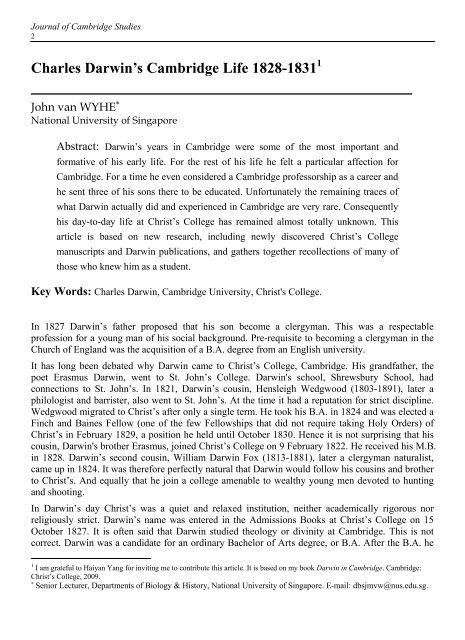
![[180] XXX. Notes on the Eflécts produced by 25720 Ancient Glaciers](https://img.yumpu.com/49145077/1/144x260/180-xxx-notes-on-the-eflects-produced-by-25720-ancient-glaciers.jpg?quality=85)
